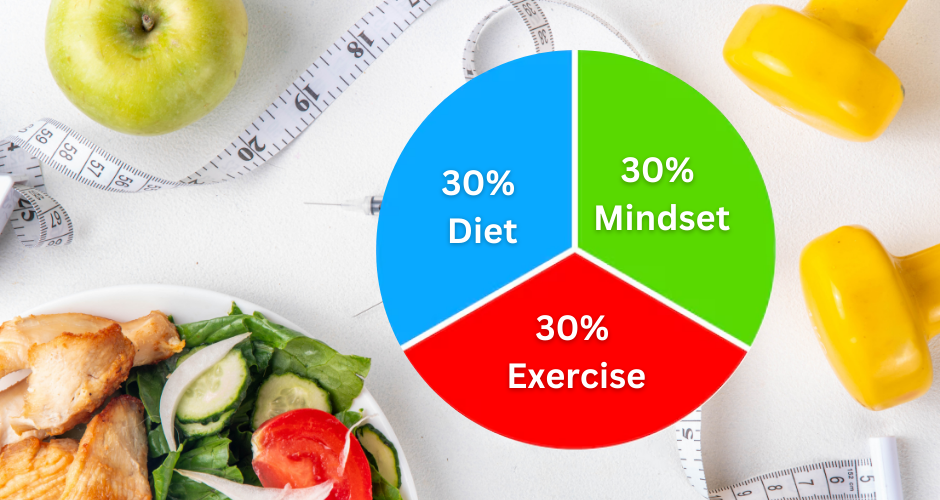What is the 30/30/30 Rule for Weight Loss?

When it comes to weight loss, we often hear about the importance of healthy eating, exercise, and lifestyle habits. But what if there was a simple, easy-to-follow rule that could help you achieve your weight loss goals while keeping things balanced? Enter the 30/30/30 Rule—a fresh approach to weight loss that’s as straightforward as it sounds!
But, what is the 30/30/30 Rule for Weight Loss, and how does it work for weight loss? In this article, we’ll dive into this popular rule and explore how it can revolutionize your fitness journey.
The Basics of the 30/30/30 Rule
At its core, the 30/30/30 Rule is about balance—balancing your diet, exercise, and lifestyle choices to help you reach your weight loss goals in a more holistic way. The rule divides your efforts into three simple categories, each contributing 30% to your overall success. Here’s the breakdown:
- 30% Diet: What you eat is crucial. Proper nutrition fuels your body and supports weight loss.
- 30% Exercise: Regular physical activity plays a huge role in burning calories and building lean muscle.
- 30% Mindset: Your mental approach, motivation, and mindset contribute significantly to staying on track.
Each of these three components plays a vital role in helping you lose weight effectively and sustainably. Let’s dive deeper into how you can apply the 30/30/30 Rule in your daily routine.
1. 30% Diet: Fueling Your Body with the Right Nutrition
The first “30” of the 30/30/30 Rule focuses on the foods you put into your body. It’s not about drastic restrictions or fad diets but rather making smarter, healthier choices to help support your weight loss goals.
Key Principles for a Diet That Supports Weight Loss:
- Eat Whole Foods: Prioritize nutrient-dense, whole foods like fruits, vegetables, lean proteins, whole grains, and healthy fats. These provide your body with the vitamins, minerals, and fiber it needs while keeping your hunger in check.
- Portion Control: Even healthy foods can lead to weight gain if portion sizes are too large. Focus on mindful eating by listening to your body’s hunger cues and practicing moderation.
- Limit Processed Foods and Sugar: Processed snacks, sugary drinks, and fast food can be high in empty calories and provide little nutritional value. Cutting back on these will help your body burn fat more efficiently.
- Hydrate: Staying hydrated is key. Water helps with digestion, suppresses appetite, and keeps your metabolism running smoothly.

Example:
A balanced breakfast might consist of oatmeal with chia seeds, almond butter, and fresh berries, providing fiber, protein, and healthy fats to start your day off right.
Learn here Does Sweating Help You Lose Weight?
2. 30% Exercise: Move Your Body to Burn Calories
Exercise is the second important piece of the 30/30/30 puzzle. While diet accounts for a significant portion of weight loss, physical activity helps you burn calories, build muscle, and improve overall health.
Tips to Make Exercise Part of Your Weight Loss Plan:
- Incorporate Both Cardio and Strength Training: Cardio exercises like running, cycling, or swimming help burn calories and improve cardiovascular health, while strength training builds lean muscle, which in turn boosts metabolism.
- Make It Consistent: Aim for at least 30 minutes of physical activity most days of the week. This could be anything from brisk walking to a high-intensity interval training (HIIT) session.
- Find Activities You Enjoy: Exercise shouldn’t feel like a chore. Whether it’s dancing, yoga, or hiking, find a form of movement that you love, making it easier to stick to your routine.
- Increase Your Activity Throughout the Day: In addition to structured workouts, try to stay active by taking the stairs, walking more during the day, or doing quick bodyweight exercises at home.

Example:
You might start with 20 minutes of HIIT, followed by 10 minutes of strength training focusing on key muscle groups. You could finish off with a brisk 10-minute walk to cool down.
Want to know Do Men Lose Weight Faster Than Women?
3. 30% Mindset: Mental Clarity and Motivation
The final “30” is all about mindset—how you mentally approach your weight loss journey. Your attitude toward the process, your ability to stay consistent, and your motivation play a huge role in your success. A positive, focused mindset can keep you on track and help you weather the challenges that come with weight loss.
Key Mindset Practices for Weight Loss:
- Set Realistic Goals: Break your larger weight loss goals into smaller, manageable milestones. This keeps you motivated and provides a clear path forward.
- Practice Patience: Understand that weight loss takes time. Celebrate small victories, whether it’s sticking to your exercise routine for a week or noticing how your clothes fit differently.
- Visualize Success: Use visualization techniques to imagine yourself achieving your goals. This can help reinforce your commitment and inspire action.
- Stay Accountable: Find a support system—whether it’s a workout buddy, a coach, or an online community. Being accountable to others can keep you motivated and help you overcome obstacles.
- Positive Self-Talk: Avoid being too hard on yourself. Embrace progress and focus on how far you’ve come rather than perfection.
Example:
Each morning, take a few minutes to set your intentions for the day. Remind yourself of why you started this journey and how it will improve your overall well-being. Positive reinforcement can help you stay on track.
Check out Does Keto Diet Really Work for Weight Loss?
Why the 30/30/30 Rule Works
The beauty of the 30/30/30 Rule is that it encourages a balanced approach to weight loss—focusing on all the key factors that contribute to success. It’s not about perfection; it’s about consistency in all areas of your life. When you dedicate 30% of your effort to eating nutritious foods, 30% to regular exercise, and 30% to maintaining a healthy mindset, you’ll see sustainable, long-term results.
The Bottom Line
The 30/30/30 Rule provides a simple yet effective approach to weight loss, making it easier for anyone to follow. By balancing your diet, exercise, and mindset, you can create a routine that supports your goals without feeling overwhelmed. Remember, small, consistent actions lead to significant results. So, give this rule a try and watch your transformation unfold—inside and out!






